Over the last few years, temperature blankets have been taking the crafting world by storm (pun intended). And it’s easy to see why! They’re fun to make, can incorporate lots of colors, and have the potential to be a truly unique gift or heirloom piece.
To make one, the basic concept is that you work a row for each day in a color that corresponds to that day’s temperature. Work in plain garter stitch or single crochet, or follow a simple pattern that lets all those beautiful colors shine.
The temperature blanket phenomenon is one example in the rise of the “data art” movement, where artists turn numeric information into something tangible and aesthetically pleasing. Learn more about data art and see some gorgeous artwork here.
You can track all kinds of information into your knitting, not just weather! Perhaps you remember the public transit delay scarf that was making the rounds online earlier this year, where one knitter made a scarf that chronicled the length of delays she faced on her commute to work in Munich.
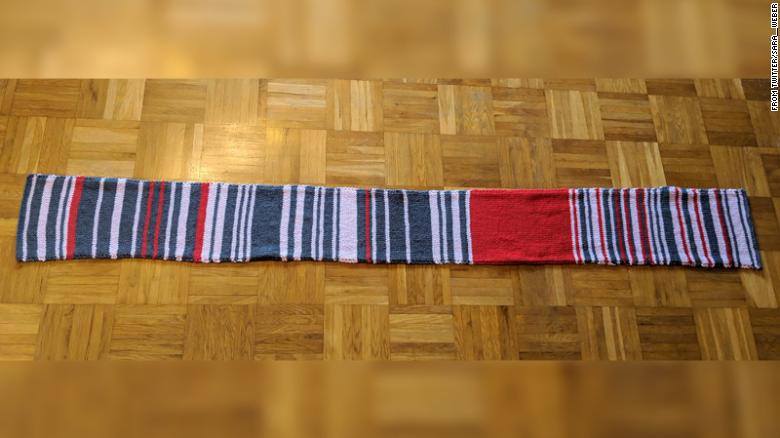
If – like us – you’re most excited about documenting the seasons around you into your yarncrafting for your very own piece of “data art”, the start of a new season is a great time to begin your own temperature blanket. Of course, you don’t have to make this project for the year ahead… You can choose to commemorate a big life event instead, like making one for the year and location a couple got married, or for a baby’s first year.
Whether you choose this year or a different time period, weather tracking websites are essential in this process. Lots of crafters recommend Weather Underground for gathering historical weather info: https://www.wunderground.com/
The color range is the key you will work from to determine which color to work with each day. See the sample color chart below, which we created for the climate in New York City using Vanna’s Choice yarn.
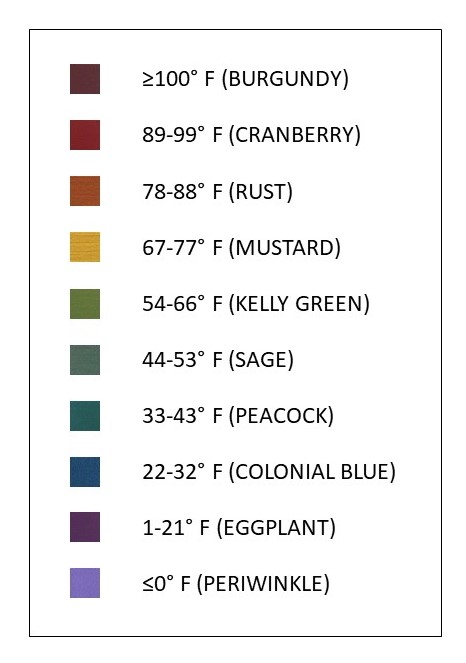
We want to encourage you to consider your own climate and get creative! If your climate is different (like if your city rarely sees freezing temperatures), you may want to adjust the temperature ranges. And of course, you can always substitute other colors.
Since color variation is the star of the show in temperature blankets, we recommend keeping the pattern itself quite simple. Patterning options include traditional stripes, granny squares, log cabin, chevron, and more.
If you want to work from a written pattern, here are a few pattern options to consider:
| Summer Stripes Afghan | Knit |
| Updated Ripple Afghan | Knit |
| Cozy Ripple Lapghan | Crochet |
| Stripes Blanket | Crochet |
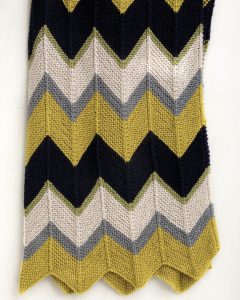
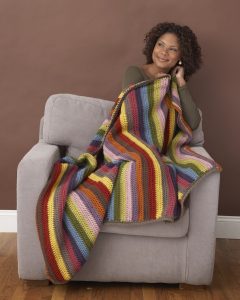

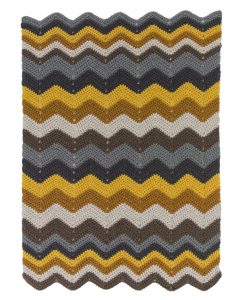
There are quite a few temperature groups and patterns on Ravelry, where you can brainstorm about your design and see what other crafters are making.
And you can find inspiration on Instagram too!
Susan A Barton
Temperature blanket alternative:
I live in Mesa AZ where our lowest to highest range is pretty extreme to say the least. At the lowest, we may have a “high” for the day of 51 degrees, or in mid-summer more like 118 degrees. I have blocked out my colors by 5 degrees instead, but next year I may cut back to 10 degrees. My coldest stripe is black for 46 to 50 degrees, then navy, purple violet, royal blue, medium purple, grey heather, light blue, lettuce, white, lemon, gold for 96 to 100 degrees, then pumpkin, carrot, cherry red, and burgundy for 116 to 120. The stripes are fairly thin, so a 10 degree range would have a larger impact.
In the six years we’ve lived here, it’s never gotten over 118 degrees, so I can easily see how the temperature ranges from year to year. Without question, this is the coldest winter we’ve ever endured. I made my first temperature afgan in 2016 and didn’t have a clue about size, it fits our queen sized bed beautifully and we use it all year. With constant air conditioning through the summer, it is the perfect weight. Since then, I’m just doing lap blankets for 3 seasons and my grand daughter wants the 2017 one to keep. After this lap blanket is finished in October, I’ll just resort to scarves and the 10 degree range! Much less commitment!
Linda Clark
I went to the main Bloglovin and found your bed cover. I haven’t crocheted in a long time, but I do quilt. I will be using up a bunch of scraps to make my temperature quilt. A whole year – 365 pieces if fabric strips.
Catherine McClarey
I joined the Comfort for Critters Facebook group, and several of us have been making monthly temperature blankets for shelter pets (the pattern and suggested color-coding are in the “Files” tab of their Facebook page. There is also a link to the pattern via Ravelry, so you can see several of the completed temperature pet blankets via the “Projects” tab of the Ravelry pattern link, as well as on the CFC Facebook page.
Karen Malabre
For my temperature blanket, I decided to make 1 square for each month, and use the average temperature for each month to determine the color of each row. I am using the birthstone color for each month for the temperature at average or above. For example, the burgundy color I used for garnet in January is crocheted for the row if the temperature that day is equal to or above 43 degrees (the average in January). Otherwise, I use white. I am using the most basic Tunisian stitch for my pattern and am chaining 35 for each square of the blanket. After the month is ended, I make all the squares 31 rows by simply filling in February, for example, with 3 more white rows. Then I am doing a half-double crochet border of 2 rows in white.
When I am finished with this blanket, I am going to put the squares together, do another 2 rows of border, and then make tassels all the way around the border, edging the blanket with the color of the square that matches for the short distance. So in the January corner, I will make burgundy and white tassels in that corner of the blanket on both sides, then switch to amethyst color purple at the edge of the second square, etc.